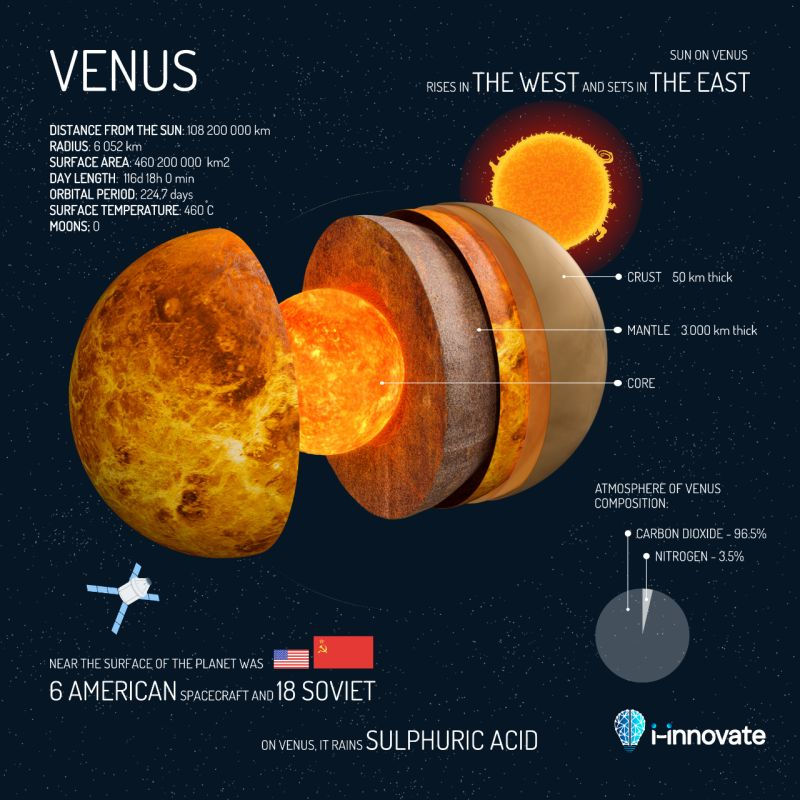Venus
- Nguyen Khoa
- Jun 23
- 3 min read
Updated: Aug 4
Venus’s runaway greenhouse effect and crushing atmosphere make it one of the most hostile planets in the solar system.

Introduction
Venus is the second planet from the Sun and is nearest to Earth. It's roughly as big as Earth, but a whole lot hotter, and spins the opposite way. It glows so brightly in the sky you can see it with your naked eye!
Possibility of Life
Venus was named after the Roman goddess of beauty and love, and it is the only planet named after a woman. Most surface features are also named after great women, real or mythological. While Venus' surface is far too hot to contain life as we know it, the upper cloud layer of Venus has pressures and temperatures similar to those found at Earth's surface. Scientists also discovered dark markings in the clouds that can take in UV radiation—maybe the result of unfamiliar chemicals, aerosols, or even extremophytic microbes. But there's no immediate evidence of life present, only provocative possibilities.
Properties
Property | Information |
Size and Location | Distance from Sun: ~108 million km (0.72 AU) Diameter: ~12,104 km (Earth = ~12,756 km) Distance from Earth: Closest approach is ~38 million km We can see Venus often in our sky—so bright that ancient people thought it was two separate stars: the Morning Star and the Evening Star. |
Rotation and Orbit | One rotation on Venus: ~243 Earth days One year on Venus (orbital period): ~225 Earth days Venus rotates in a retrograde manner, so the Sun rises in the west and sets in the east. Its axial tilt is only about 3 degrees, so it has no noticeable seasons. |
Moons and Quasi-Satellite | Venus doesn't have a moon but it does have a quasi-satellite called Zoozve, an asteroid which orbits within the synchrony of Venus around the Sun. It's not quite a moon but it's nearby as its orbit is in sync differently. |
Rings | Venus has no rings. |
Surface and Geology
Venusian surface shaped by volcanism and tectonics:
Thousands of volcanoes (possibly some still active)
Unique features such as:
"Pancake domes" – wide, flat volcanoes
"Tick domes" – volcanoes with spidery ridges
Tesserae – highly deformed highlands with crisscrossing ridges
Mountains (some over Mount Everest's height)
Few impact craters, suggesting a geologically young surface
Soviet Venera probe images show a rocky, barren surface under a thick yellowish sky.
Internal Structure
Venus likely comprises:
A metallic iron core
A molten rock mantle
A possibly once tectonically active crust Some scientists believe there can still be subduction zones, which would be the first move towards plate tectonics.
Atmosphere and Climate
Made up of mostly carbon dioxide (CO₂)
Thick clouds of sulfuric acid
Creates a runaway greenhouse effect, which causes surface temperatures greater than 475°C
Atmospheric pressure is 90 times that of Earth
Upper atmosphere with high winds, reaching 360 km/h
Magnetic Field
Venus has no internal magnetic field like Earth's. Instead, it has an induced magnetic field, created by the solar wind interacting with its ionosphere. This weak field is shaped like a comet’s tail due to the flow of particles from the Sun.

Summary
Studying Venus enables scientists to investigate:
Global warming and the greenhouse effect
The evolution of a planet and why two nearly identical planets evolved so differently
The existence of life elsewhere
Venus potentially had oceans and an Earthlike climate at one point but was changed into the hell world that it currently is by something. By studying Venus, we better understand our home planet—and what may lie ahead for others.


Comments